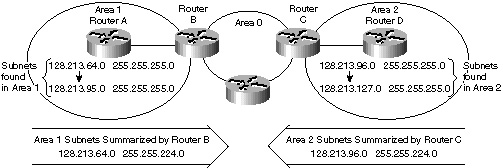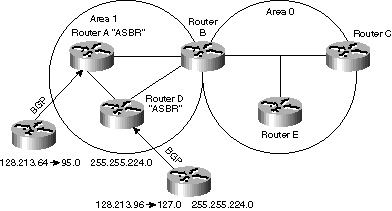The Fundamentals of OSPF Routing Design
Inter-Area Route Summarization Inter-area route summarization is done on ABRs, and it applies to routes from within the AS. It does not apply to external routes injected into OSPF via redistribution. To take advantage of summarization, network numbers in areas should be assigned in a contiguous way so that you can lump these addresses into one range when summarizing them. To specify an address range, perform the following task in router configuration mode: area area-id range address mask The area-id is the area containing networks to be summarized. The address and mask will specify the range of addresses to be summarized in one range. Figure 5-14 illustrates an example of summarization.
In Figure 5-14, Router B is summarizing the range of subnets found within area 1 from 128.213.64.0 to 128.213.95.0 into one range: 128.213.64.0 with a mask of 255.255.224.0 into the backbone. This is achieved by masking the first three left-most bits of 64, using a mask of 255.255.224.0. In the same way, Router C is generating the summary address 128.213.96.0 255.255.224.0 into the backbone. Note that this summarization was successful because you have two distinct ranges of subnets, 64-95 and 96-127 in areas 1 and 2 respectively. It would be hard to summarize if the subnets between area 1 and area 2 were overlapping. The backbone area would receive summary ranges that overlap and routers in the middle would not know where to send the traffic based on the summary address. The following is the relative configuration of Router B, and you can extrapolate Router C’s configuration as well: Router B# router ospf 100 area 1 range 128.213.64.0 255.255.224.0 External Route Summarization External route summarization is specific to external routes that are injected into OSPF via redistribution done by ASBRs. Also, make sure that external ranges being summarized are contiguous. Summarization that overlaps ranges from two different routers could cause packets to be sent to the wrong destination. Summarization is done via the following router ospf subcommand: summary-address ip-address mask This command is effective only on ASBRs doing redistribution into OSPF. In Figure 5-15, Router A and Router D (both ASBRs) are injecting external routes into OSPF by redistribution. Router A is injecting subnets in the range 128.213.64-95 and Router D is injecting subnets in the range 128.213.96-127.
To properly summarize the subnets into one range on each router, you can configure the routers as follows: Router A# router ospf 100 summary-address 128.213.64.0 255.255.224.0 redistribute bgp 50 metric 1000 subnets Router D# router ospf 100 summary-address 128.213.96.0 255.255.224.0 redistribute bgp 20 metric 1000 subnets This will cause Router A to generate one external route 128.213.64.0 with a mask of 255.255.224.0 and will cause Router D to generate one external route 128.213.96.0 with a mask of 255.255.224.0. Note that the summary-address command has no effect if used on Router B because Router B is not doing the redistribution into OSPF, nor is it an ASBR. Route Summarization and Route DistributionRoute summarization addresses two important questions of route information distribution:
If you know the answers to these questions, you will be able to effectively design how you need to summarize routes within your OSPF network. Area-to-Backbone Route Advertisements There are several key considerations when setting up your OSPF areas for proper summarization. OSPF route summarization occurs in the ABRs. OSPF supports variable length subnet masks (VLSM), so it is possible to summarize on any bit boundary in a network or subnet address. OSPF requires manual summarization. As you design the areas, you need to determine summarization at each ABR. Backbone-to-Area Route Advertisements Four potential types of routing information exist in an area and are listed in Table 5-2, which shows the different types of areas according to the routing information that they use.
The types of routes defined in Table 5-2 for OSPF areas are as follows:
OSPF Addressing and Summarization ScenariosThe following sections discuss OSPF route summarization and the three most commonly encountered IP addressing scenarios:
| ||||||||||||||||||||||||||||||||||||
EAN: 2147483647
Pages: 200

